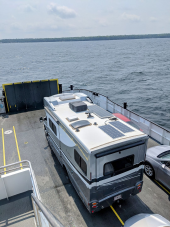I may have made my first post too complicated so I'm going to post just one question.
I would like to put 600W+ on my RV roof.
Ive looked at HQST 100W compacts and Newpowa 210W (12 or 24V) panels.
Is there any advantage/disadvantage to 3 vs 6 panels? Right now - they are both basically $0.85-0.88 a watt.
I know with 6 I would have a little more flexibility with 3S2P or 2S3P. With the larger panels I'm pretty much locked into 3S I think (would need some pretty heavy gauge wiring to go 3P).
PS - I am currently considering dumping my converter, and 2KW inverter and going with this: Sigineer M3024NC but that would would require building 24V battery setup and a 24->12V buck and still leaves me wondering if I can start my generator with 24V.
I would like to put 600W+ on my RV roof.
Ive looked at HQST 100W compacts and Newpowa 210W (12 or 24V) panels.
Is there any advantage/disadvantage to 3 vs 6 panels? Right now - they are both basically $0.85-0.88 a watt.
I know with 6 I would have a little more flexibility with 3S2P or 2S3P. With the larger panels I'm pretty much locked into 3S I think (would need some pretty heavy gauge wiring to go 3P).
PS - I am currently considering dumping my converter, and 2KW inverter and going with this: Sigineer M3024NC but that would would require building 24V battery setup and a 24->12V buck and still leaves me wondering if I can start my generator with 24V.




